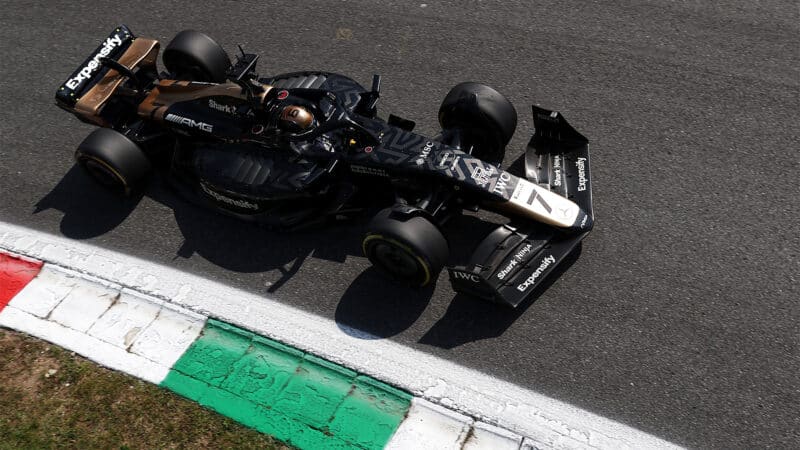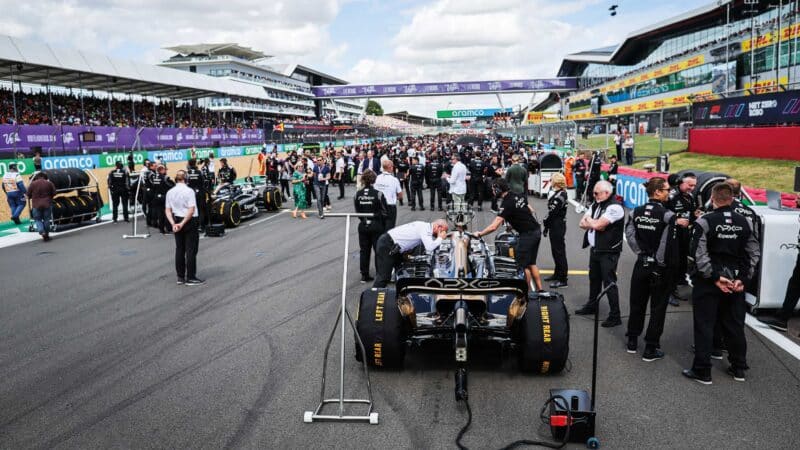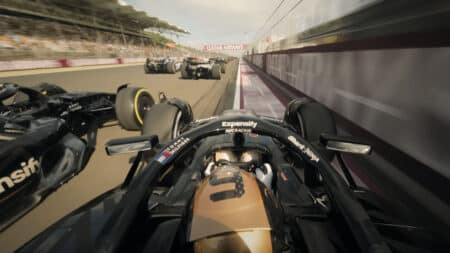As filming has continued, the APXGP team have also included subtle ‘upgrades’ to its car’s design to ensure another sense of realism. In 2023, simplified downwashing sidepods were added, as were cooling louvres which were fitted on top of the bodywork. There’s also an array of fake tyre sensors while changes were also made the front wing endplates.
But due to the use of a F2-chassis, there are limitations as to how far the APXGP car can be ‘developed’. In side-by-side comparisons with a regular 2024 F1 car, APXGP cars are approximately 400mm shorter and 100mm narrower – causing everything to look a little squashed together. Underneath the bodywork, the car is also far less intricate than the rest of the grid, with metal rods holding in place parts of the floor in order to moderate floor flex. The venturi tunnels underneath the car – which are a key design point in ground effect aerodynamics – are also simplified and smaller in size.
Due to its smaller and narrower body, APXGP cars also use marginally smaller and lighter tyres than their F1 counterparts. Each car is fitted with F2-spec Pirellis, which share the same 18-inch diameter as the F1-spec tyre but are 55mm narrower and offer less grip.
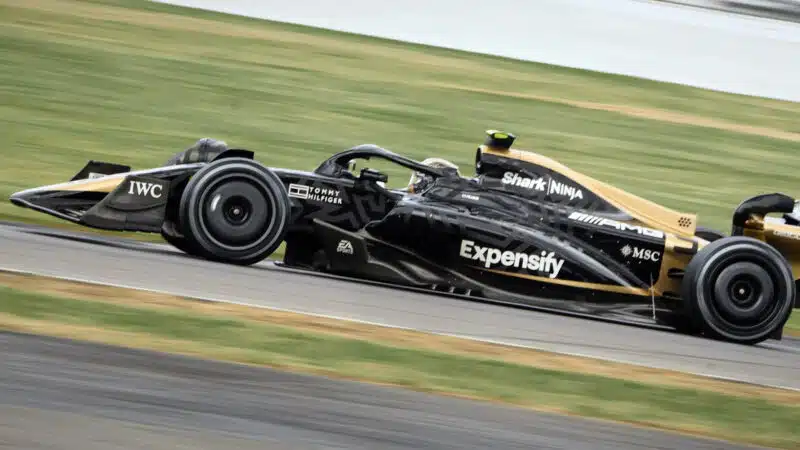
APXGP on track at Silverstone
The attention to detail across the APXGP car arguably makes it look as if its cut from the same F1 cloth as Mercedes’ W15 or Ferrari‘s SF-24, but where it differs most is at the rear.
Alongside an F2 chassis, APXGP cars house an F2 engine: a 3.4-litre V6 Mecachrome retrofitted with a Van der Lee turbocharger which produces approximately 620bhp and is driven by a six-speed Hewland gearbox. The engine’s manufacturer, was briefly involved in F1 from 1998-1999 after taking over Renault‘s engine programme, but has been the sole engine supplier to F2 since 2018.
Conversely, the 1.6-litre V6 engines utilised by the rest of the F1 grid produce approximately 1000bhp, use a hybrid powertrain and are developed by one of four manufacturers: Ferrari, Mercedes, Renault, and Red Bull Powertrains.
But, although they may not perform like the real-deal, Mercedes has ensured that the APXGP machines are “fundamentally” race cars of reasonably similarity.
“We worked with Mercedes and this was actually Toto Wolff’s idea,” director Joseph Kosinski told Deadline. “At one of our first meetings, Toto said: ‘You should build this off a Formula 2 car, but make it look like a Formula 1 car,’ so it’s a Formula 2 chassis and engine.
“We worked closely with Mercedes and their design team and aerodynamicists to develop a custom body that resembles the latest generation Formula 1 car. They’re built specifically for this movie. They also have 15 camera mounts built into them, including the recorders and the batteries and the transmitters.
“They’re made for shooting movies, but they are fundamentally race cars.”
F1 cars and APXGP — what’s the difference?
| Car | Formula 1 | APXGP |
| Top speed | 220mph+ | 208mph |
| DRS | Yes | Yes |
| Engine size | 1.6-litre V6 | 3.4-litre V6 |
| Approximate power | 1000bhp | 620bhp |
| Tyre size | 18-inches | 18-inches |
| Car size | 5.63m x 2m x 0.95m | 5.23m x 1.9m x 1.09m |
What is the top speed of Brad Pitt’s F1 car?
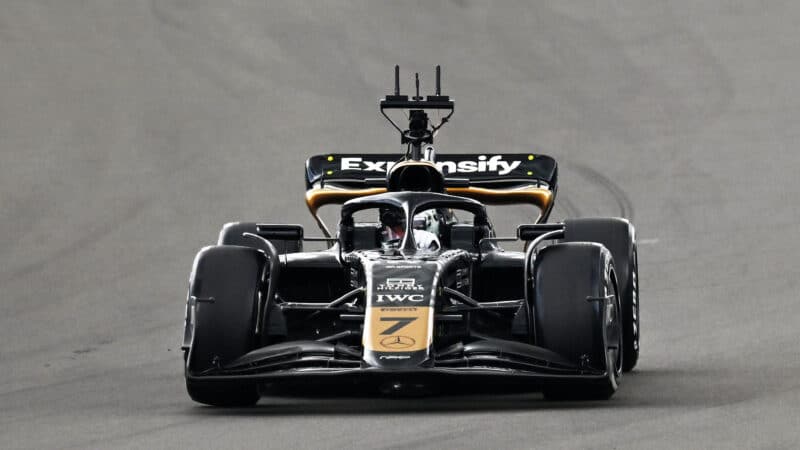
How fast will Brad Pitt go in his APXGP machine?
Getty Images
Although the APXGP machine may look and sound like the real-deal, its performance won’t quite match up to the rest of the F1 field — but Brad Pitt and company could still reach speeds of up to 200mph during filming and testing at certain circuits.
There is yet to be an official lap time posted at any circuit by an APXGP car, but with F2-like performance, it could expected to lap at similar speeds. At the 2024 British Grand Prix, the F1 pole time, set by George Russell, was 1min 25.819sec, while the F2 pole time, set by Isack Hadjar around the same circuit, was 1min 39.368sec.
Who will drive the cars in Brad Pitt’s new F1 film?
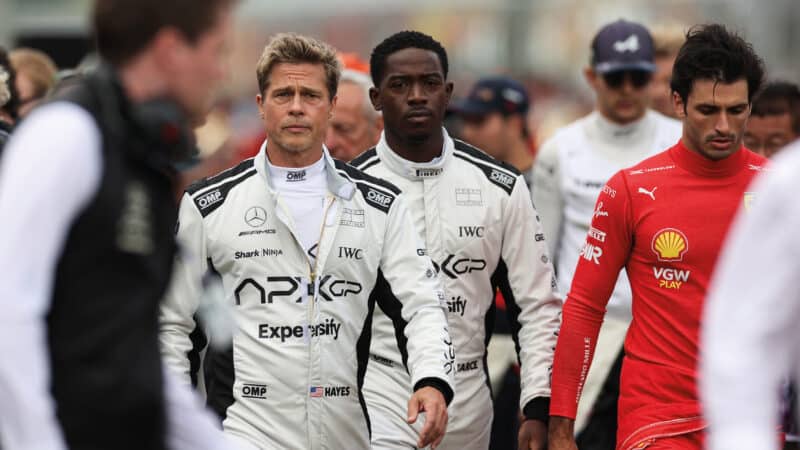
Brad Pitt and Damson Idris managing to blend in
Getty Images
Both Brad Pitt (Sonny Hayes) and Damson Idris (Joshua Pierce) have been behind the wheel on several grand prix weekends and during test days, which has taken months of practice and preparation.
As well as helping to build the fleet of APXGP cars, Toto Wolff revealed that Mercedes had also sent Pitt to a driving school in France, where he progressed from driving Formula 4 cars “all the way up” to Formula 1.
